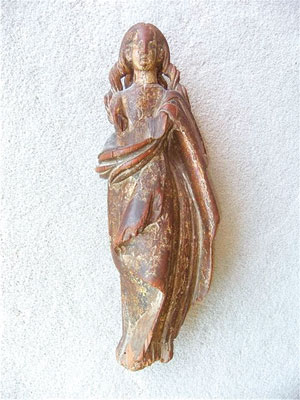
LS attended a financial planning seminar lead by the great Santa Barbara money guru JP. JP suggests to her clients that they contact me to establish the value of their “stuff” for planning purposes. Thanks to the Wiz JP!! LS sent me a batch of photos from her grandmother’s estate. One of the figures caught me off guard – a German carved polychrome oak or lime wood figure of the Virgin, or possibly the second most important female saint after St. Barbara, namely St. Catherine. It appears to originate in the 15th or 16th century. I see traces of gold gilding on top of a red glaze, highly typical of the South German “Santos” (although that’s not a German term) late medieval style.
Because of the pattern on the gilding I don’t believe the little Virgin/Saint was originally “polychromed.” In other words, painted or enameled in more than one color. Monochromatic pieces of “Saint-carvings” like this are expected, as they were often mounted into a gaudy highly decorated church altarpiece. How do I know this little figure was more than likely mounted into a Baroque altarpiece? Because of her elongated proportions, meant so the viewer sees her from slightly below, in adoration. Not only the elongation, but the “sway” of her drapery (clothing) indicate to me she was part of a “setting.” The little figure looks like her weight (if she was a human female) balances on one leg, and her draperies follow the “S” curve of her body.
Usually, such a sensuous figure and stance was reserved for Saint Catherine, whose martyrdom is most like our own Santa Barbara’s. She was the beautiful, long-haired young maiden daughter of the King and Queen of Alexandra (Egypt) in the 4th century. She refused to marry a non-Christian husband, saying she planned to remain a virgin, married only to Christ. The Pagan Emperor Maxentius, who proposed marriage to her, upon her blanket refusal, had plans to break her on “The Wheel.” When faced with the wheel of torture Catherine’s power caused the wheel to disappear. The Pagan Emperor Maxentius, of course, infuriated, beheaded her. Thus Catherine’s representation in art is usually very sensual and alluring, and we see LS’s figure possesses long hair and feminine curves
As a matter of fact she was said to continue to remain beautiful after her death. The Apocrypha claims Catherine’s body was discovered in 800 or so at the base of Mt. Sinai, with her hair still growing. Many Medieval devotees made a pilgrimage to her grave, and Renaissance Europe saw the emergence of a Catherine cult.
What is LS’s figure worth? The most famous of all Germany Northern Renaissance icon-makers in wood was Tilman Riemenschneider (1460-1531). The last little saint figure discovered carved by him sold in 2008 at Sotheby’s NY for $6,313,000. So LS, bring this little sculpture into my office ASAP.